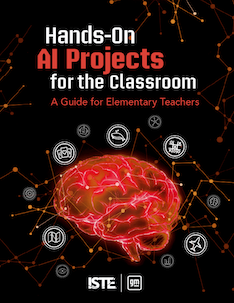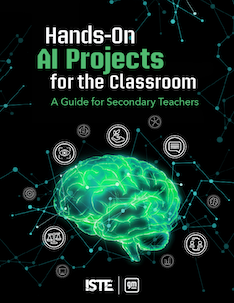ISTE's Hands-On Projects for the Classroom: AI Series
As part of it's Artificial Intelligence Lessons, ISTE has created many useful resources for you. Below are linked two of 5 available lessons.
Example Prompt
Create a STEM lesson plan for 2nd grade using the 5E model that covers 3 days of instruction and uses a children's storybook to engage learners. Align the lesson with this learning standard: [LEARNING STANDARD HERE]. Include a final performance assessment that is aligned with the learning standard. Include 3 references of learning theories that were used in the lesson plan. Ensure that the lesson plan is designed using principles from Universal Design for Learning.
Additional Reading
Kalenda, P., Rath, L., Abugasea Heidt, M., & Wright, A. (2015). Pre-service teacher perceptions of ChatGPT for lesson plan generation. Journal of Educational Technology Systems 53(3), 219-241. https://doi.org/10.1177/00472395241301388
Lo, L. S. (2023). The CLEAR path: A framework for enhancing information literacy through prompt engineering. The Journal of Academic Librarianship, 49(4), 102720. https://doi.org/10.1016/j.acalib.2023.102720
About Your Presenters
Dr. Peter Kalenda is an assistant professor of Science and Math education at the Ella Cline Shear School of Education at SUNY Geneseo where he teaches courses in elementry science and math methods to future teachers.
Dr. Logan Rath is a Librarian at Drake Memorial Library at SUNY Brockport where he supports the development of information literacy in future teachers.
Updated Blooms for AI from Oregon State eCampus
Use this table as a reference for evaluating and considering changes to aligned course activities (or, where possible, learning outcomes) that emphasize distinctive human skills and/or integrate generative AI (GenAI) tools as a supplement to the learning process.
All course activities and assessments will benefit from ongoing review given the evolving capabilities of GenAI tools.
| Heading | How GenAI Can Supplement Learning+ | Distinctive Human Skills |
|---|---|---|
| CREATE | Support brainstorming processes; suggest a range of alternatives; enumerate potential drawbacks and advantages; describe successful real-world cases; create a tangible deliverable based on human inputs. | Engage in both creative and cognitive processes that leverage human lived experiences, social-emotional interactions, intuition, reflection, and judgment to formulate original solutions. |
| EVALUATE | Identify pros and cons of various courses of action; develop and check against evaluation rubrics. | Engage in metacognitive reflection; holistically appraise ethical consequences of other courses of action; identify significance or situate within a full historical or disciplinary context. |
| ANALYZE | Compare and contrast data, infer trends and themes in a narrowly-defined context; compute; predict; interpret and relate to real-world problems, decisions, and choices. | Critically think and reason within the cognitive and affective domains; justify analysis in depth and with clarity. |
| APPLY | Operate, implement, conduct, execute, experiment, and test in the real world; apply human creativity and imagination to idea and solution development. | Make use of a process, model, or method to solve a quantitative or qualitative inquiry; assist students in determining where they went wrong while solving a problem. |
| UNDERSTAND | Accurately describe a concept in different words; recognize a related example; translate to another language. | Contextualize answers within emotional, moral, or ethical considerations; select relevant information; explain significance. |
| REMEMBER | Recall information in situations where technology is not readily accessible. | Retrieve factual information; list possible answers; define a term; construct a basic chronology or timeline. |
+ AI capabilities derived with reference to an analysis of the MAGE framework across multiple disciplines, based on ChatGPT 4 as of October 2023. See Zaphir, L., Lodge, J. M., Lisec, J., McGrath, D., & Khosravi, H. (2024). How critically can an AI think? A framework for evaluating the quality of thinking of generative artificial intelligence. arXiv preprint arXiv:2406.14769.
UNESCO Summary from Notebook LM
NotebookLM
K-12 AI curricula emphasize a range of thematic areas and learning outcomes designed to prepare students for life and work in the AI era. The goal is for citizens to understand the impact of AI, its capabilities and limitations, when it is useful, and how it can be steered for the public good, while also ensuring foundational skills like literacy and numeracy are not lost.
The curricula are broadly structured around three main categories of content, which collectively account for the majority of teaching time:
- AI Foundations (average 41% of curriculum time)
- Ethics and Social Impact (average 24% of curriculum time)
- Understanding, Using, and Developing AI (average 25% of curriculum time) An additional 10% may be unspecified.
Here's a detailed breakdown of the key thematic areas and their associated learning outcomes:
Key Thematic Areas
The nine core topic areas within K-12 AI curricula are:
- AI Foundations:
- Algorithms and Programming: This forms a basis for technical engagement with AI. It is the largest share within AI foundations.
- Data Literacy: Focuses on managing the data cycle (collection, cleaning, labelling, analysis, reporting) and understanding its role in AI's ethical and logistical challenges.
- Contextual Problem-Solving: Frames AI as a solution to business or social challenges, integrating concepts like design thinking and project-based learning. Curricula engaging this area often invest heavily in it as part of a project-based learning cycle.
- Ethics and Social Impact:
- Ethics of AI: Covers ethical terms (bias, fairness, representation), the meaning of 'ethical AI', and avenues for redress in cases of unethical use. This area tends to draw a high percentage commitment from curricula with the smallest hour commitments.
- Social/Societal Implications of AI: Addresses broader impacts like workforce transformation, changes to legal frameworks, and new governance mechanisms. Only 12 out of 21 curricula included social implications.
- Applications of AI to other Domains: Explores AI applications beyond computer science in areas like art, music, social studies, science, and health, pertinent to everyday interactions. This topic area accounts for about half of the time allocated to the 'ethics and social impact' category.
- Understanding, Using, and Developing AI:
- Understanding and Using AI Techniques: Involves theoretical understanding of AI processes (e.g., patterns, machine learning models) and using existing AI algorithms (e.g., training a classifier). This accounts for more than half of this category's time.
- Understanding and Using AI Technologies: Focuses on human-facing applications like Natural Language Processing (NLP) and computer vision, and the processes behind their creation.
- Developing AI Technologies: Deals with creating new AI applications, which is a specialized field requiring knowledge in coding, mathematics (statistics), and data science. This area generally has the lowest average allocation among the three main categories.
Learning Outcomes
Learning outcomes in AI curricula are defined across three domains: knowledge (cognitive demands), skills (psychomotor aspects, including analysis and revision of artifacts), and values and attitudes (guiding principles and beliefs).
1. Knowledge Outcomes
Students are expected to:
- Understand fundamental AI concepts: Including what AI is (and is not), its basic features, definitions of 'weak' and 'strong' AI, and the history of its development.
- Grasp algorithms and programming: Such as abstraction, decomposition, pattern recognition, the roles of algorithms in computation, their definitions, components (input, steps, output), and processes (training, testing, deployment). This also includes knowledge of programming languages and simulations.
- Develop data literacy: Including data trends, collection and analysis principles, different types of information sources, and the characteristics of structured and unstructured data.
- Comprehend AI techniques: Like supervised, unsupervised, reinforcement learning, machine learning (ML), deep learning (DL), neural networks, and Generative Adversarial Networks (GANs), and how data is used in predictions.
- Understand AI technologies: Such as computer vision, Natural Language Processing (NLP), sensors, autonomous systems, and recommender systems, often comparing them to human perception.
- Recognize applications across domains: Identify and explain AI use cases in everyday life, including how AI drives various software and physical systems, and its applications in different professions.
- Understand ethical and societal implications: Define ethical terms like bias, fairness, and privacy in relation to AI, understand issues of access to technology, algorithmic bias, intellectual property, data security, and the principle of explainable AI. They should also reflect on AI's advantages and disadvantages, its role in everyday life and work, its environmental impacts, and issues of misinformation (e.g., deepfakes) and gendered consequences.
2. Skills Outcomes
Students are expected to be able to:
- Apply computational thinking and algorithms: Recognize patterns, follow and formulate instructions, create algorithms and flowcharts, develop predictive models, and optimize computational procedures.
- Program and develop applications: Construct simple code scripts using block-based or text-based programming (e.g., Python), control robots, and develop secure, user-friendly programs.
- Engage in contextual problem-solving: Design, develop, and employ strategies for solving real-life problems through decomposition and pattern identification, and evaluate technological solutions.
- Manage and analyze data: Save, sort, visualize, search for, collect, and organize data, manipulate data with spreadsheets, work with relational databases, and evaluate data quality and accuracy.
- Utilize AI techniques and technologies: Classify objects, construct decision trees, design workflows for AI algorithms, clean data for ML, build classifiers, chatbots, and autonomous robots, and use existing AI technologies to develop new products.
- Collaborate and innovate: Work as part of a team, use design thinking methodology for projects, create innovative solutions using AI tools, and manage technology-development projects.
- Practice ethical engagement: Protect personal data, identify bias in algorithms, identify stakeholders, build ethical matrices, manage digital identities, undertake self-advocacy, and write guidance for ethical AI development.
- Critically evaluate social impacts: Properly dispose of technology, identify deepfakes, recognize threats to equal opportunities, critically analyze digital content for manipulation, and contribute to public discourse.
3. Values and Attitudes Outcomes
Curricula aim to develop:
- Personal values: Such as interest in ICT, persistence/resilience in problem-solving, personal empowerment through project creation and advocating for rights, reflection on AI's impact on future work and society, critical thinking in evaluating information, and entrepreneurship in developing innovative ideas.
- Social values: Including collaboration/teamwork and communication through group projects and ethical guideline creation.
- Societal values: Such as respect for others (including data privacy), personal responsibility (e.g., proper technology disposal, understanding human control over AI), integrity (mitigating bias, transparency), and tolerance for different ideas.
- Human values: Encompassing respect for the environment/sustainable mindset (understanding technology's environmental impact, reducing computational costs) and commitment to equity (reflecting on access to AI and the inequity caused by computational costs).
These comprehensive learning outcomes aim to equip students with the necessary knowledge, skills, and ethical understanding to navigate a world increasingly shaped by AI.

